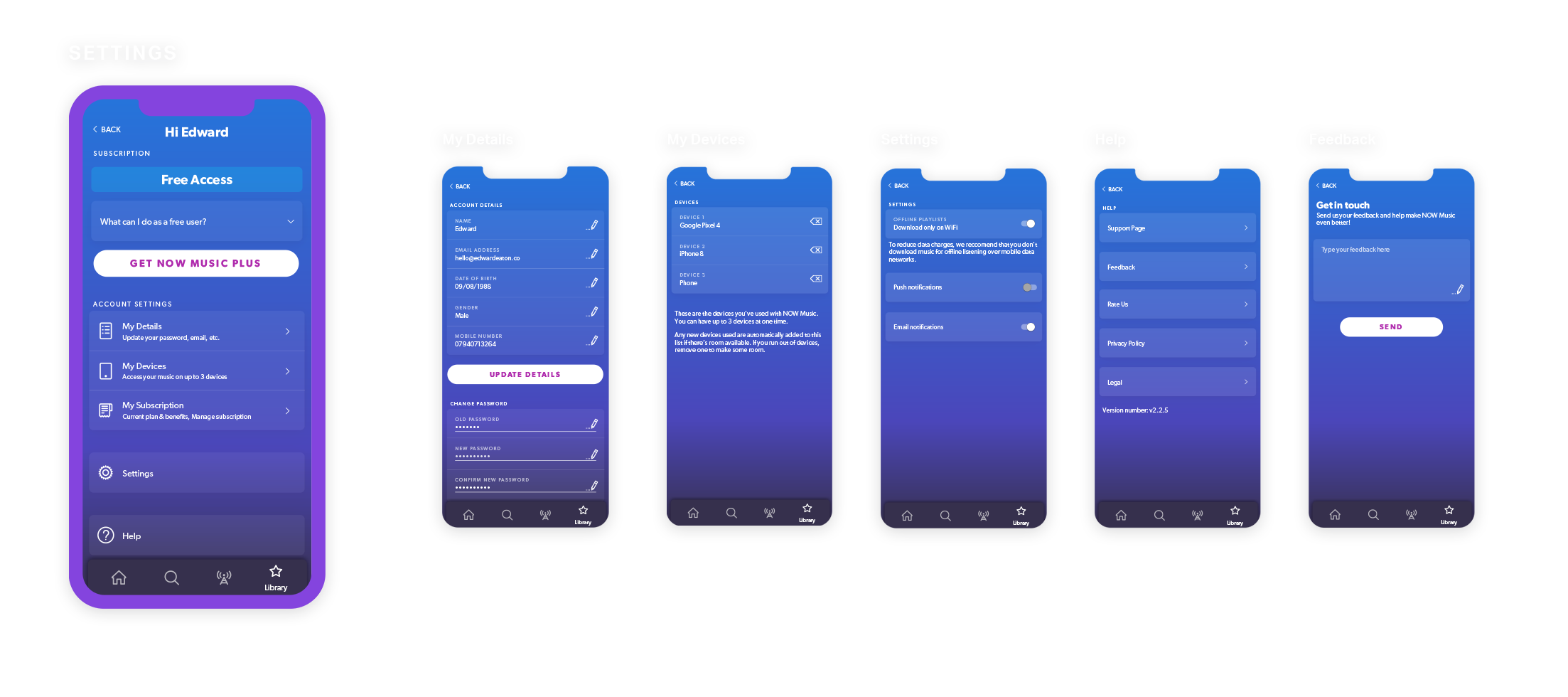
NOW Music app
Client: Sony Music
NOW That’s What I Call Music had moved into the digital space. They outsourced an MVP to an agency. The product was doing well, but they weren’t happy with it from a design or UX perspective.
Challenge: Redesign the digital product to better represent the NOW That’s What I Call Music brand and expand existing features within the constraints of licensing agreements.
My role: Design lead
Platform: iOS, Android, Tablets, & TV
Team: 1 product manager, 1 product owner, 1 designer, 3 full stack developers, 8 front end developers, 4 back end engineers, 1 marketing manager
Year: 2018-2020
B U I L T W I T H
Analysis
I conducted Interviews the team to identify what they wanted from the app. The team expressed wanting the app to look more adult, editorial wanted to be able to curate better, the head of product and digital wanted the app to keep users for longer and the engineers wanted to capture more data.
Sony already had a ton of great user research on the demographic and NOW That’s What I Call Music. Identifying that NOW Music is seen as a curator, uniter, and memory maker and it’s brand recognition was one of it’s strongest assets. These attributes helped guide the design process for features.
Data from the app was at best unreliable and at worst irrelevant. User churn after the first month was a concern and through interviews it was discovered that users typically streamed the same few albums but felt the app didn’t feel personal.
Update the digital product
Logo
For a brand with such a strong visual identity. Virtually no branding assets were available when picking up the project. This first task was to rebuild the logo maintaining the NOW That’s What I Call Music heritage in a way that let us broadcast their new digital product and maintain it’s visual identity.
Brand recognition was one of Now That’s What I Call Music’s greatest assets. For that reason only minor changes to the logo could be made. We remodelled and textured the original logo from scratch.

Typography
The app was using 4 weights and inconsistent sizes of Gibson. The first step was the reduce the variance in font sizes and apply consistent use of styles.
Colour
NOW That’s What I Call Music’s album covers are an explosion of colour. We needed a colour pallet that could act as a canvas to those covers. Hues of calming blues and purples were chosen as the apps primary colours after extensive testing and competitor analysis.
Tertiary Colours
I did a colour analysis of the last 20 years of NOW That’s What I Call Music album covers and distilled a tertiary colour list from that. This helped the app fit within the NOW ecosystem.
Iconography
The NOW That’s What I Call Music albums have a strong visual impact. The iconography should reflect that & work within that aesthetic. Taking colours from the 106+ albums released, fine tuning and applying them into simple icons that reflect moods the content team wanted to convey.

Homepage
The NOW Music app was hard coded. This meant developers had to be instructed on what albums to display in the old layout. As the user-base grew a more diverse range of listening habits needed to be catered to and this wasn’t possible with a hard coded homepage.
We designed the page dynamically around components. Not only could the order of elements on the homepage be changed on an individual basis, but also the content within those components.
Carousel Component
We started with the carousel component. Where the contents of the carousel could be changed by the content team, or set up with tags to show personalised content. For example a users most listened to albums or playlists.
Radio Component
We were able to generate radio stations based off user listened for genres artists and moods within the app. We wanted to bring these to the users homepage based on their own listening habits. For example someone listening to a lot of Ariana Grande could see a Pop, R&B and Arian Grande stations in their radio carousel.
Content Lenses
We also wanted to bring relevant genres out of the search menu and into the homepage. These would change according to a users most listened to genres. We also included the ability to program genre’s in for holidays and world events.
Editorial
Editorial components thought the CMS allowed us to bring the content team’s excitement for music to the user and give the app a human touch.
Web Link
We also created a component that would let the content team link out of the app. This let us run deals and campaigns from the the website and advertise them in app.
Full length dynamic homepage example
Tablet home screen
Search
Search was one of the most requested features. However licensing agreements with the labels meant the app wasn’t able to play a song from a specific artist on request. Through idea sessions with the product and developer teams we came up with the idea for search to to show a user all the albums and curated playlists an artist showed up in. Tapping them would then take the user to the point in that album/playlist where the song was.
The licence also reduced the amount of songs available on the platform to tens of thousands. Knowing it was possible to search without getting any results, we wanted to be able to show the artists we did have. For this we leveraged predictive search to show some of the catalog without it having to be searched for.
The licensing terms were regularly up for negotiation so we experimented with different levels of access to music catalogues. The example below was used to try and negotiate the inclusion of artist pages. Showing how they could be used to promote albums or playlists from the labels themselves.














